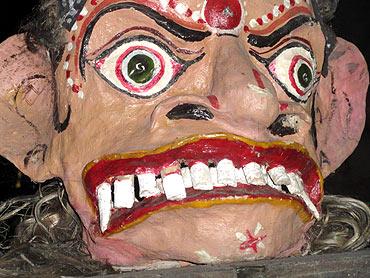 | « Back to article | Print this article |
This oasis of peace may soon be wiped out
This idyllic island in the heart of the mighty Brahmaputra in Assam finds a special place on the global map. It happens to be the largest inhabited river island on this planet.
Majuli is also a throbbing centre of Vaishnav culture popularised by saint Srimanta Sankardeva in the 16th century.
A population of 1.52 lakh, including nearly 70,000 members of the ethnic Mising tribe, inhabit the island. The island is also famous for its numerous Satras or Vaishnav monasteries.
This island -- a melting pot of religion, folk culture and tradition -- is facing a grave danger due to the Brahmaputra gradually eroding away its land mass. According to available data, the area of the riverine island was 1,256 sq km in 1991; it is only 450 sq km today.
Because of the relentless erosion, the number of Satras (monasteries) at Majuli has been reduced to 22 from 65.
Reportage: K Anurag in Guwahati
This oasis of peace may soon be wiped out
Although crores have been spent on Majuli's development and protection from erosion, proper roads and bridges on this picturesque island have remained a distant dream for its dwellers.
Principal sources of livelihood for the island dwellers are paddy cultivation, horticulture, fishing, weaving and pottery making.
According to geologists, a massive earthquake in 1950 had hit the region with such intensity that the bed of Brahmaputra River was thrust upwards, causing the river to change its course. Since then, the river has been chipping away the land mass of Majuli.
Majuli's Satras (monasteries) however remain a major source of attraction for visitors seeking some peace and solace in the comfort of nature.
This oasis of peace may soon be wiped out
"Every year, a number of tourists and research scholars visit these centuries-old Satras in Majuli and get awed by the ambience and exemplary practice of the rich Vaishnav culture," said Nitul Dutta.
Dutta is an official at the revered Auniati Satra, which was established way back in 1653, and is currently residing in its fifth abode.
The four earlier ones couldn't survive the steady erosion by the Brahmaputra.
These monasteries are also storehouses of art and culture. Most of the old Satras in Majuli are treasure troves of ancient literature preserved in their ancient form. They are invaluable mementos from the glorious past when they were patronised by the powerful Ahom Dynasty.
This oasis of peace may soon be wiped out
Fortunately, a few Satras including Auniati have been able to preserve those invaluable items.
Some of these valuable possessions include water pots made of pure gold and silver, large silver dishes, ivory artefacts and heavy swords of the Ahom period.
"We have so much treasure but there is no proper place to put those on display for visitors. The museum building has remained under construction for years," rued Naren Kataki, a senior priest of Dakshinpat Satra.
The Satras survive on the donations of their disciples across Assam. Satras officials travel across the state after the harvesting season to collect funds and food grain every year.
Besides its continuous efforts to promote Vaishnav culture, Satras also teach Satriya dances and different types of plays on Lord Krishna and his various incarnations.



